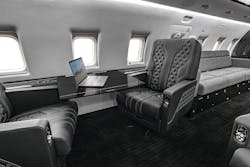Nothing makes an old aircraft feel new again like, well, a brand-new interior. A full interior refurbishment is all about making a customer’s dream aircraft come true, meaning it’s a much more labor-intensive project than others.
“When I say ‘full interior refurbishment,’ it could be everything from taking out cabinetry and replacing the coverings, rebuilding cabinetry, making new cabinetry to modifying cabinetry to fit a special vision or a customer’s desires or wants. It includes floor covering, window panels, headliner panels – taking those out, stripping them down; pulling foam off materials, window shade assemblies, drink rails, lower side walls – everything from the baggage all the way to the floor of the cockpit is removed from the aircraft,” described George Bajo, manager, completions service sales for Duncan Aviation.
Anything with material such as fabric or vinyl, Bajo continued, gets pulled off and that process also gets into reconfiguring the cabin.
If there’s a need or a mission requirement for it, new seats will be bought or seats will be moved around, new configurations will be engineered and certified, Bajo said. LED lighting upgrades and cabin management systems, TVs, monitors, switch panels, even coffee makers, microwaves and refrigerators can be part of a refurbishment, he said.
Planning the Process
The work-intensive process starts by meeting with the customer, hashing out as many details as possible – from what their vision for the aircraft is, to what work has been previously done, what materials the customer might want used and more.
“We want to talk through it,” said Meghan Welch, director of paint and interior sales, Elliott Aviation. “We either invite them to our facility, help them understand the process, meet with them face to face to start to develop that relationship. Or we can also do it through a Zoom call or meet with them at their facility. Whatever works best for them.”
Whatever the venue, the meeting is tailored to the specific customer’s aircraft and includes the ins and outs and possibilities for their refurbishments. Welch said they want to make sure the customer has all the information possible, including what some of the latest design and style trends out there are, which can help with resale value down the road.
“We want to make sure that customers understand what their different options may be, because we never want them to say, ‘I wish I would've known.’ We always want them to say, ‘I'm glad that I knew all my options and made these selections accordingly.’ So, we really want to make sure we outlined what all the different capabilities, modifications, opportunities are for their refurbishment,” Welch said.
This pre-planning stage is one of the most crucial parts of the refurbishment process, and these days needs to take place earlier and earlier.
“You have to preplan and in a lot of cases it's a challenge because we don't know what the market's going to do in two months. We don't know what the market's going to do in a year. And you don't know if your business is going to grow in a year or stay stagnant for a year. And you base your decisions on what you're going to do in the aircraft based off of that. We really appreciate that our clients are understanding that there is a requirement to hold capacity six months out, eight months out, and this will change. I've been doing this for a while and I haven't seen this amount of work booked out this far, but clients understand that you have to start thinking and scheduling early,” Bajo said.
Client involvement doesn’t just end at the planning stages. Often customers will be brought in during the midst of the process to give their opinion.
“We like to have our customers have direct access to our employees, so they can ask the question. We don't want to ever do this in a vacuum without the customer's input. We like their input. We want them to be a part of it. So, they feel better about the purchase and they feel better about making some decisions going through the process,” Bajo said.
For instance, he said they will often get a customer’s input on paint to make sure they like a color scheme before applying it or have them test out a seat before it’s installed to make sure it’s to their comfort level.
“I highly recommend customer involvement at all different phases,” said Bajo.
Getting the Work Done
Downtime for a project as intensive as a total interior refurbishment can be extensive. Welch said because of this, they find many customers opt to have other maintenance performed on their aircraft at the same time.
“A lot of times when customers do the refurbishment process, because it is an extended downtime, they'll include maintenance with it, like avionic upgrades, paint refurbishment. So, they'll try to, depending on the inspections, try to see if there's multiple work that they can do to try to minimize any downtime opportunities. So what happens is when the aircraft comes to our facility, what we'll do is, we do all of our incoming inspections. For example, if it's going through paint and interior, our paint shop will go in and they'll do their incoming inspection, walk around the aircraft, do all their checks that they need to do,” she said.
“Then the interior will do all their incoming inspections at the same time the interior gets removed and then goes to all the back shop.”
From there, the different departments get to work on their projects, such cabinetry and soft goods. Each department works together to minimize downtime.
“We just try to figure out a great schedule for that aircraft to minimize downtime as best as we can. Then once the aircraft is done with the maintenance, the paint’s doing all the final details, then the interiors being reinstalled into the aircraft, the carpet's getting cut. So there's, again, multiple shops working on the aircraft at the same time,” Welch described.
Performing the dance needed between departments requires deft timing and communication to make sure all pieces come together at the right time.
“There's a lot of timing that occurs with these large interior refurbishment projects between the shops. The key component there is communication and things don't always go correct in every refurbishment and sometimes, and a lot of times, we have to be flexible and adjust our schedules around another department.
“So, interior might have to work around airframe or install or whatnot because of a part that didn't show up or a part that didn't work. Something like that. It's that synergy you got to have between departments to maintain the schedule,” said Bajo
Luckily, with proper planning, most challenges should be able to be overcome as they arise.
“The front part of the project really sets the stage for the back part of the project. Having a good design group, getting involved with the customer on the front side, being very detailed in the proposals of what the client wants to do. What is expected of the department, the shop that's going to do the refurbishment, the intent of the proposal, all that has to be communicated properly,” Bajo said. “That's what I recommend to all the owners and clients – get all the details. And if you have a question, get it in the proposals – get the answer in the proposal.”
Welch said the same – to overcome challenges, outline as much as you can ahead of starting the work.
“The goal of all projects is to outline all the work scope ahead of time, be prepared and planned before the project starts. And that way then you can run that project through. It’s really just trying to get ahead of the game, doing all your pre-planning, all your forecasting of scheduling, engineering, all the materials, getting all those selections done, getting any equipment ordered ahead of time, coordinating all those lead times. So everything is planned, organized outlined prior to that project starting.”
With everything outlined ahead of time, Welch said any hurdles that arise during the refurbishment process should be able to be tackled by onsite engineering and modification teams.
About the Author
Walker Jaroch
Editor
Contact: Walker Jaroch
Editor | AMT
+1-920-568-8399
>> To download the AviationPros media kits, visit: Marketing Resource Center
>>Check out our aviation magazines: Ground Support Worldwide | Airport Business | Aircraft Maintenance Technology

